Filter by
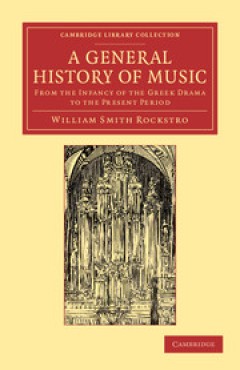
A General History of Music
A friend and pupil of Mendelssohn, the composer and author William Smith Rockstro (1823–95) was regarded as an expert on early music. He contributed articles on the subject to Sir George Grove's Dictionary of Music and Musicians as well as teaching counterpoint and plainsong at the Royal College of Music. His published output includes biographies of Handel (1883), Mendelssohn (1884) and the o…
- Edition
- -
- ISBN/ISSN
- 9781107300125
- Collation
- -
- Series Title
- Cambridge Library Collection - Music
- Call Number
- -
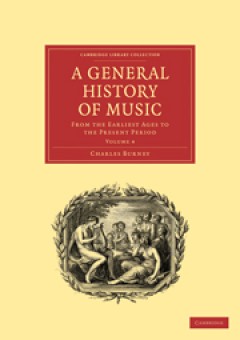
A General History of Music
Charles Burney (1726–1814), was the foremost music historian of his day. The General History, his most famous work, was published in four volumes between 1776 and 1789 and is still of great value today. Burney wanted to write something which would appeal to and inform the musician and the general reader. Research for the History was undertaken during two European tours, in 1770 and 1772, cons…
- Edition
- -
- ISBN/ISSN
- 9780511711220
- Collation
- -
- Series Title
- Cambridge Library Collection - Music
- Call Number
- -
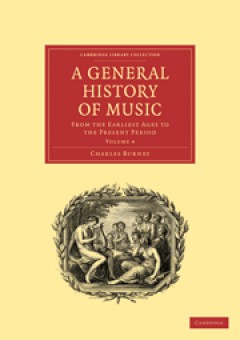
A General History of Music
Charles Burney (1726–1814), was the foremost music historian of his day. The General History, his most famous work, was published in four volumes between 1776 and 1789 and is still of great value today. Burney wanted to write something which would appeal to and inform the musician and the general reader. Research for the History was undertaken during two European tours, in 1770 and 1772, cons…
- Edition
- -
- ISBN/ISSN
- 9780511711206
- Collation
- -
- Series Title
- Cambridge Library Collection - Music
- Call Number
- -

A General History of Music
Charles Burney (1726–1814), was the foremost music historian of his day. The General History, his most famous work, was published in four volumes between 1776 and 1789 and is still of great value today. Burney wanted to write something which would appeal to and inform the musician and the general reader. Research for the History was undertaken during two European tours, in 1770 and 1772, cons…
- Edition
- -
- ISBN/ISSN
- 9780511711237
- Collation
- -
- Series Title
- Cambridge Library Collection - Music
- Call Number
- -

A General History of Music, from the Earliest Times to the Present
The writer, composer and organist Thomas Busby (1754–1838) is best remembered for his highly entertaining Concert Room and Orchestra Anecdotes (1825), which paints a vivid picture of musical life at the time. The son of a coach painter, Busby was originally articled to the composer Jonathan Battishill, but found the experience unrewarding. His compositions (many now lost) include songs, theat…
- Edition
- -
- ISBN/ISSN
- 9781139833745
- Collation
- -
- Series Title
- Cambridge Library Collection - Music
- Call Number
- -

A General History of Music, from the Earliest Times to the Present
The writer, composer and organist Thomas Busby (1754–1838) is best remembered for his highly entertaining Concert Room and Orchestra Anecdotes (1825), which paints a vivid picture of musical life at the time. The son of a coach painter, Busby was originally articled to the composer Jonathan Battishill, but found the experience unrewarding. His compositions (many now lost) include songs, theat…
- Edition
- -
- ISBN/ISSN
- 9781139833752
- Collation
- -
- Series Title
- Cambridge Library Collection - Music
- Call Number
- -
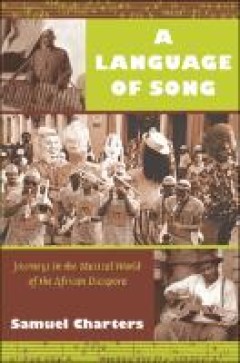
A Language of Song: Journeys in the Musical World of the African Diaspora
In A Language of Song, Samuel Charters—one of the pioneering collectors of African American music—writes of a trip to West Africa where he found “a gathering of cultures and a continuing history that lay behind the flood of musical expression [he] encountered everywhere . . . from Brazil to Cuba, to Trinidad, to New Orleans, to the Bahamas, to dance halls of west Louisiana and the great c…
- Edition
- -
- ISBN/ISSN
- 9781478090717
- Collation
- -
- Series Title
- -
- Call Number
- -

Instruments for New Music
Player pianos, radio-electric circuits, gramophone records, and optical sound film—these were the cutting-edge acoustic technologies of the early twentieth century, and for many musicians and artists of the time, these devices were also the implements of a musical revolution. Instruments for New Music traces a diffuse network of cultural agents who shared the belief that a truly modern music …
- Edition
- -
- ISBN/ISSN
- 9780520963122
- Collation
- -
- Series Title
- -
- Call Number
- -
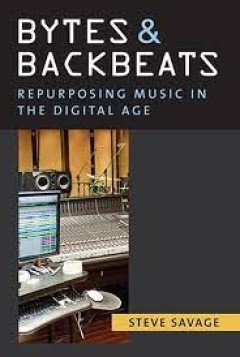
Bytes and Backbeats Repurposing Music in the Digital Age
From Attali's "cold social silence" to Baudrillard's hallucinatory reality, reproduced music has long been the target of critical attack. In Bytes and Backbeats, however, Steve Savage deploys an innovative combination of designed recording projects, ethnographic studies of contemporary music practice, and critical analysis to challenge many of these traditional attitudes about the creation and …
- Edition
- -
- ISBN/ISSN
- 9780472901180
- Collation
- -
- Series Title
- -
- Call Number
- -
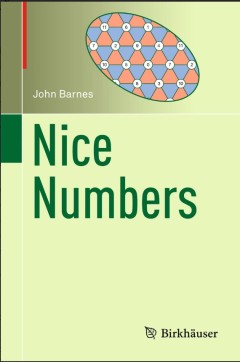
Nice Numbers
In this intriguing book, John Barnes takes us on a journey through aspects of numbers much as he took us on a geometrical journey in Gems of Geometry. Similarly originating from a series of lectures for adult students at Reading and Oxford University, this book touches a variety of amusing and fascinating topics regarding numbers and their uses both ancient and modern. The author informs and…
- Edition
- 1
- ISBN/ISSN
- 978-3-319-46830-3
- Collation
- XIII, 329
- Series Title
- -
- Call Number
- -
 Computer Science, Information & General Works
Computer Science, Information & General Works  Philosophy & Psychology
Philosophy & Psychology  Religion
Religion  Social Sciences
Social Sciences  Language
Language  Pure Science
Pure Science  Applied Sciences
Applied Sciences  Art & Recreation
Art & Recreation  Literature
Literature  History & Geography
History & Geography